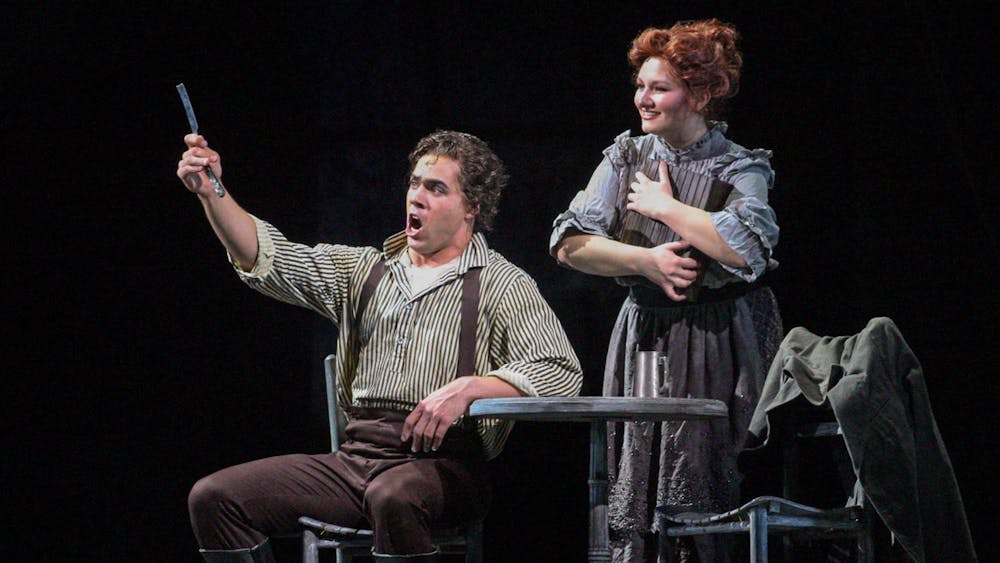At an Oct. 5 rehearsal at the Musical Arts Center, ballet dancers in spandex pants, leotards and sweatshirts helped move the velvet railing from the front of the stage before beginning one of their last rehearsals before the Fall Ballet, "Through a Looking Glass."\nA few days later, these dancers would be dressed in Spanish-style tutus and colorful leotards, bathed in the colorful MAC stage lights, performing in front of ballet fans, friends and family. But for the time, they were still preparing for the first show of the season in a way their teacher, former prima ballerina Violette Verdy, said exhibited all their good qualities.\n"Ballet is like the Cinderella of the arts," Verdy said, quoting an old dance adage. "We're humble, but we're very powerful."\nVerdy added that humility, as well as other qualities, is a way of life for these dancers.\n"Ballet dancers never get that fun, never money like rock stars. You learn service, honesty, sincerity, humility," Verdy said. "They burn so much of their negative energy that they don't have it anywhere else."\nWhether they will enjoy fame or fortune one day, both Verdy and John Clifford, visiting choreographer and current artistic director of the Los Angeles Ballet, emphasized that many of the ballet dancers at the IU School of Music are at a professional level of talent and technique already.\n"The dancers, they're just as good as any company," Clifford said. "Everybody runs off to see these touring companies, and they're fine, but the quality here is so high. The next time they see these dancers, they'll pay $50 more to see the same people."\nClifford, who is currently working with Warner Bros. on a ballet based on the classic film "Casablanca" that will open in China next year, believes in IU dancers so much that he said he is thinking about offering several of them jobs in the future.\nClifford has already choreographed a ballet specifically for IU dancers. The third section of "Through a Looking Glass" was the world premiere of Clifford's choreography to Philip Glass' electronic composition, "Glassworks." \nClifford said he put together the intricately produced light show, including several colors and a sometimes dim stage with only a few dancers illuminated, along with minimal solid-colored costumes and flowing choreography to create "a sense of a lava lamp."\n"I wanted everybody to have sort of an out-of-body experience," Clifford said.\nClifford's modern choreography of this piece followed "Viva Vivaldi," a Spanish-esque piece choreographed by Gerald Arpino, visiting artist and current director of the Joffrey Ballet of Chicago, and staged by new ballet faculty member Guoping Wang. This is a piece that Clifford called "very fast, very hard technically and rather aerobic."\nThe accompaniment by the classical guitar work of Andrés Saborío Rodríguez, a master's student of Maestro Ernesto Bitetti, and the Kuttner Quartet gave the piece both a Spanish and Italian flavor, Verdy said.\nOn Friday night, Josh Grayson, a junior studying piano, said he thought the performance of "Viva Vivaldi" was very well done.\n"They captured the atmosphere and the essence of Vivaldi," Grayson said.\nThe second section of the performance, Maurice Ravel's "Sonatine," included the original choreography of George Balanchine, the legendary choreographer of the New York City Ballet.\nBoth Verdy and Clifford have worked with Balanchine in the past. Verdy, along with former IU Department of Ballet Theatre chair Jean-Pierre Bonnefoux, danced in the world premiere of this duet at the Ravel Festival at the New York City Ballet in 1975.\n"Balanchine wrote for the dancers, so he chose and exploited all your qualities and pushed you further," Verdy said.\nClifford, who danced and choreographed with Balanchine, also emphasized the appeal of Balanchine's choreography to "Sonatine."\n"All of (Balanchine's) ballets are positive about life. It makes it good to be a human. Everyone thinks ballet is a feminine art form, but it's both. It's a human art form," Clifford said.\nJunior Jenna Wolf, who was double cast with freshman Lauren Fadeley in the role originally choreographed for Verdy, said learning the role from Verdy was like "getting a first-hand taste of it."\n"It's kind of getting it straight from the horse's mouth, since Balanchine isn't around anymore," Wolf said.\nAccompanied by the sweet, shimmering piano provided by graduate student Ligia Takei, Wolf and senior Joseph Morrissey, who was double cast in the male role with sophomore Justin Zuschlag, performed Balanchine's precise, sophisticated choreography on Friday night.\nVerdy said while the ballet is not as aerobic as pieces like "Viva Vivaldi," its level of difficulty is high.\n"It's so intimate and subtle. The dancers must control all these little things. You may not have danced hard, but the control," Verdy said.\nBoth Verdy and Clifford emphasized that dancers at the IU Ballet Theatre department have an opportunity to learn and excel in ways that dancers who do not study at a university cannot. \nClifford said that while there is some competition between the dancers at IU, it is less ferocious and more friendly.\n"It's a much healthier atmosphere here than at a ballet company. All these kids are friends and you don't see that other places," Clifford said.\nVerdy said she and the other ballet faculty members try to preserve a healthy atmosphere for the dancers by being very supportive of their needs. \n"We really help them mature, and they go through angst that if they went through it in a company they'd have no help. We help them," Verdy said. \nVerdy and Clifford both said they also make the dancers work but not endlessly repeat things that they already know. Both Verdy and Clifford said their training with Balanchine impressed this value upon them. They agreed that their goal is to create a performance that is "not overcooked" but "well done."\n"They get bored. You give them a few things that keep it fresh. If you rehearse it to death, then it becomes a well-rehearsed act and the spontaneity is gone," Clifford said.\n-- Contact staff writer Melissa Harrold at mejharro@indiana.edu.
The Cinderella of the arts: BALLET
IU trains dancers to become professionals
Get stories like this in your inbox
Subscribe





